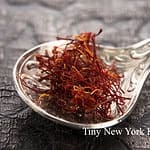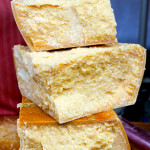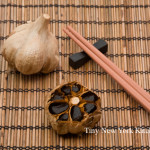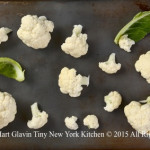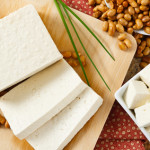Saffron
Highly prized as a dye, medication and culinary spice since Greek and Roman times, saffron is the stigma of a type of crocus, Crocus sativus, which was once grown all over Europe, including in England. It has a distinctive and lasting aroma, and a pleasant pungency if used sparingly. Because of its striking color, as well as its distinctive flavor, saffron is frequently added to celebration dishes; for example, pilaus from India, Spanish paella and Italian risotto Milanese. Bouillabaisse, the famous French fish and shellfish soup-stew, is flavored with saffron. The spice is also widely used in sweet recipes, including milky rice and sweet custard-like desserts. Baked goods flavored with saffron include breads and cakes.
Saffron threads can be infused (steeped) in a little warm water or milk until the color of the liquid is even. Add the liquid and the threads to the dish, usually towards the end of the cooking process. Saffron powder can be added to food without soaking, but not to hot oil.
“Work With What You Got!”
© Victoria Hart Glavin Tiny New York Kitchen © 2016 All Rights Reserved
Parmesan Cheese Rinds
I tend to use a lot of good quality Parmesan cheese that I grate myself all the way down to the rind. I used to just toss the rinds until one day a chef friend told me all of the ways to use them. I think of them as the bay leaves of the cheese world. Add them when you’re cooking a dish and make sure to remove them at the end of cooking. Seriously, you’ll discover a while new world of flavor.
Throw into sauces, stews, and soups. Adding a Parmesan rind to sauces, stews, and soups will definitely add a nice rich flavor. Add to Italian dishes (both red and white pasta sauces).
Put them in a jar and pour olive oil over them. This makes Parmesan infused olive oil. You could add garlic cloves as well. This is excellent for dipping bread.
Grill them if your rinds are pure cheese with no waxy coating. They’ll become soft and chewy that is delicious on crusty bread.
Make Parmesan broth for cooking with. It’s so easy. Just add a few rinds with some herbs to a pot of water. Simmer for a couple of hours and after the broth has reduced some strain it and use to cook with.
Use them when you’re cooking vegetables.
Put a rind in the pot when you’re cooking rice or risotto.
The great news is that Parmesan rinds freeze well. You don’t need to use them right away and keep for a few months in the refrigerator. They keep for years in the freezer, however. If you don’t have any rinds on hand you may also purchase them from high-end grocers and cheese shops, where they’re super inexpensive.
www.tinynewyorkkitchen.com
“Work With What You Got!”
© Victoria Hart Glavin Tiny New York Kitchen © 2016 All Rights Reserved
Black Garlic
Black Garlic has been around for quite awhile and is an ingredient that chefs have been using across the country. Think of it as “sweet meets savory.” Black garlic is made when heads of garlic are aged under very specialized conditions until the cloves turn black and have a sticky date-like texture. The taste is delicious and unique with a sweet and earthy umami flavor that intensifies nearly any dish you’re creating.
Garlic bulbs are kept for weeks at low temperatures in a humid environment. The enzymes that give fresh garlic its sharpness break down. These conditions also facilitate the Maillard reaction, the chemical process that produces wild new flavor compounds responsible for the deep taste of seared meat and fried onions.
Black garlic’s flavor is described as tasting like aged balsamic, prunes, licorice, molasses, caramel, and tamarind. Use the cloves as you would roasted garlic. Purée with olive oil for a dense and sweet flavor all its own that compliments steaks, chicken, fish and seafood. Smear the paste on crostini or incorporate it into dressings. Use in a braise to intensify the umami-rich flavor of spare ribs. Add to soups, risotto, noodle and rice dishes, and cheese dips. Black garlic also pairs well with blue cheese.
Black garlic also comes in a dehydrated powder that is considered an umami pixie dust. Just sprinkle a bit of it on anything that begs for depth and earthiness.
Most likely you won’t find black garlic at your local neighborhood market, but some Whole Foods will carry it. I’m lucky enough to get mine at Kalustyan’s in New York City. You can certainly get it online at Amazon or other specialty online food sources.
“Work With What You Got!”
© Victoria Hart Glavin Tiny New York Kitchen © 2016 All Rights Reserved
Lunar New Year 2016
This year, the Lunar New Year will begin on Monday, February 8. It is the biggest event of the year for Chinese people and Chinese emigrants throughout the world. Although there are various styles of celebrating the Lunar New Year, the spirit behind these celebrations is the same. The beginning of the New Year marks a time for a fresh start, so people try to clean up everything completely and tie up loose ends before the end of the previous year. On New Year’s Day, people wear new clothes. This day people also pay their respects to their ancestors, so it is a family reunion day rather than a day for dining out and partying. Families go to temples to pray for deceased family members and offer them special Near Year foods.
The symbolic color of the Lunar New Year is red. Streets and houses are decorated with red ornaments bearing the characters for happiness, prosperity, peace, and spring, among others. Chinese communities literally turn red. Kids receive money from relatives in red envelopes known as hong bao.
Lunar New Year parades attract many spectators, not only those of Chinese descent, but also people outside the Chinese community. The lion dance (not a dragon dance) is the main performance of the parade. The traditional dance is based on a Chinese myth about people successfully driving away monsters. The dance has evolved as the Chinese diaspora has spread throughout the world. There are two main versions: the northern lion dance and the southern lion dance, and the latter is seen more often in the world because more Chinese immigrants are from the southern regions of China.
Firecrackers also enhance the excitement of the parade. You may think firecrackers for the Lunar New Year are too noisy and perhaps scary, but these are meant to drive away evil spirits, so they should be scary! Many people are willing to endure that noise once a year in hopes of staying away from misfortune the rest of the year.
The Lunar New Year celebration culminates with the Lantern Festival on the fifteenth day of the first month in the lunar calendar, which is the first full moon of that lunisolar year. During the event, countless lanterns are hung, decorating temples and streets at night. There are several legends associated with the festival, but the lanterns are almost always red, the color of good fortune.
Lunar New Year cuisine also differs from place to place, although there are some significant similarities. People in most regions eat something wrapped and stuffed (dumplings, spring rolls, banana leaf–or bamboo skin–wrapped sticky rice), something long (noodles), and money-like fruits (tangerines and oranges). Fillings, toppings, and sizes vary depending on the culture, but all foods symbolize good things like abundance, longevity, and prosperity. Whole fish is also symbolic main dish in most Lunar New Year celebrations.
Japanese people celebrate the first day of the New Year as well, but in a very different way. Called Setsubun, the celebration is accompanied by a special ritual of throwing beans to clean away all the evil of the former year in the lunar calendar and drive away disease-bringing evil spirits from the year to come. Roasted soybeans are thrown either out the door or at a member of the family wearing an oni (demon or ogre) mask. The throwers chant “Oni wa soto! Fuku wa uchi!” (“Get out, demons! Come on I, good luck.”)
Japanese people also customarily eat soybeans – one for each year of one’s life (if you are 25 years old, you eat 25 beans) – to usher in good luck. In some areas, people eat one bean for each year of one’s life, plus one more for good luck for the year to come (if you are 25, you eat 26 beans). Also, there are some regions where people bite into futomaki (big sushi rolls) without cutting them at all. They believe that your wish will come true if you bite into an uncut futomaki known as an echo-maki. The “roll” symbolizes “rolling good luck in,” and to bite the “uncut” roll represents not cutting this good fortune.
“Work With What You Got!”
© Victoria Hart Glavin Tiny New York Kitchen © 2016 All Rights Reserved
Paleo Diet
The Paleo Diet (short for Paleolithic) is fashioned around the eating habits and available foods of our hunter-gatherer ancestors. These ancestors had to nourish themselves with the meat, fish, fruits, vegetables, nuts, and fats available to them in nature. With the benefit of large supermarkets, it’s easy today to mimic these foods in wider variety. Specific recommendations for eating Paleo will vary; however, the main ideas are the same: Reduce the risk of debilitating diseases and optimize health by eating whole, fresh, unprocessed foods and avoid foods that were not available prior to the advent of modern agriculture.
Research studies looking at the Paleo Diet have noted that eating a Paleo Diet for a short term improved the glucose control and lipid profiles in people with type 2 diabetes, compared to eating a diet containing low-fat dairy, moderate salt intake, whole grains, and legumes. Additional research indicates similar results may be possible in people without type 2 diabetes as well. The Paleo diet may result in higher levels of satiety (fullness) throughout the day when compared with a low-fat, low-calorie diet.
Paleo Do’s
Eat plenty of non-starchy vegetables and fruits.
Make fresh meat, poultry, fish, and seafood your primary sources calories.
Avoid highly processed meats that contain preservatives, artificial flavors, and sugar, such as some sausages, bacon, deli meats, and smoked fish products.
Consume nuts and seeds.
Use coconut oil, grass-fed butter, olive oil, avocado oil, nut and seed oils, and animal fats, such as goose fat or duck fat, for cooking and eating.
Balance the intake of acid-producing foods (meats, fish, salt, and cheese) with base-producing foods (fruits and vegetables) for optimal health.
Use sea salt to season foods, but try to decrease sodium intake in general.
Paleo Don’ts
Consume highly processed packaged foods.
Get heavy handed with the salt shaker.
Eat grains of any kinds. Quinoa, bulgur, rice, wheat, bread, pasta, etc., are all out.
Consume sugar (including honey and maple syrup), sweets, candy, or desserts.
Use artificial sweeteners, such as monk fruit extract, stevia, NutraSweet or Equal (aspartame), Splenda (sucralose), or sugar alcohols, such as xylitol, sorbitol, or maltitol.
Eat legumes, beans, peas, lentils, or soy, or foods make from soybeans.
Use canola or soybean oils or consume hydrogenated oils (trans fats).
Consume dairy, with the exception of fermented dairy or raw milk cheese on occasion.
“Work With What You Got!”
© Victoria Hart Glavin Tiny New York Kitchen © 2016 All Rights Reserved
Japanese Pantry
Add these Japanese items to your pantry and you’ll reach for them again and again. Some of these items are common enough that you can find them at Whole Foods or your local health food store. Others might require a trip to an Asian grocery store or an online order. Your efforts will be richly rewarded.
Sake
You don’t need to spend a lot of money on fancy sake for cooking, but a decent bottle is tastier and more complex than cooking sake.
Kombu
This mineral rich dried kelp is what gives dishes depth. The sheets should be sturdy with fine sea salt on the outside. Look for labels that say “kombu.”
Bonito Flakes
Dried, fermented, and smoked skipjack tuna (also known as katsuobushi) that is the yin to kombu’s yang in dishes. Quality ranges widely. You do get what you pay for here.
Rice Vinegar
Avoid seasoned rice vinegar, which has sweeteners and other additives in it. Choose a brand that lists rice and water as the only ingredients.
Miso
It encompasses a range of fermented soybean pastes, from younger fresh-tasting white to long-aged, funky red. The latter, which is mellow and sweet, is the best intro.
Mirin
Brewed from sticky rice, this cooking wine is sweeter and less alcoholic than sake. Pick one made with sugar rather than glucose or corn syrup because you can taste the difference.
Togarashi & Sansho
Make fruity togarashi chile powder your new Aleppo. Sansho, made from the husks of sansho peppercorns, lends tongue-tingling anise notes.
Short-Grain White Rice
With its pearly grains and subtle flavors, koshihikari is the crème de la crème of Japanese short-grain rice.
Usukuchi Soy
Lighter, thinner, and saltier than standard soy, usukuchi is perfect for seasoning dishes like yosenabe (hot pot) without darkening the color too much.
“Work With What You Got!”
© Victoria Hart Glavin Tiny New York Kitchen © 2016 All Rights Reserved
Cauliflower
Whether roasted, mashed, raw or added to pasta dishes, there’s something so comforting about cauliflower’s mild, creamy flavor. Plus, it’s one of the most nutritious vegetables around. What’s not to love?
Cauliflower is a member of the cruciferous family, along with broccoli, cabbage, and kale. These vegetables are an important part of a heart-healthy lifestyle, high in nutrients and fiber and very low in calories.
It’s easier than you might think to separate a whole cauliflower into florets, but if you’re really pressed for time, take advantage of prepared fresh or frozen cauliflower.
To prep cauliflower you will need to first remove the cauliflower’s leaves and cut out the core. Then break into evenly sized florets, cutting any very large ones. Add to a pot of boiling salted water and cook for about 5 minutes. Drain thoroughly. Rinse with cold water if you plan on using it later.
Cauliflower works great as a replacement for higher starch foods like rice, couscous, and potatoes. Steam and mash it to replace potatoes or pulse it in a food processor to create cauliflower “rice” that can be sautéed or steamed and served with curry or chili.
“Work With What You Got!”
© Victoria Hart Glavin Tiny New York Kitchen © 2015 All Rights Reserved
Quinoa (pronounced KEEN-wah) is the high protein dried fruits and seeds of a goosefoot plant (Chenopodium quinoa); these are used as a food staple and ground into flour. Quinoa is washed before cooking to remove a bitter residue from the spherical seeds. It is treated like a grain, but it is actually the fruit of an herb and it cooks twice as fast as rice. Quinoa produces its own natural insect repellent.
“Work With What You Got!”
© Victoria Hart Glavin Tiny New York Kitchen © 2015 All Rights Reserved

